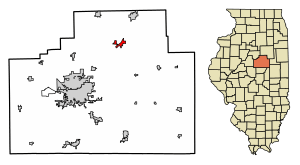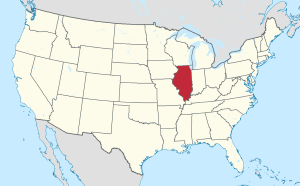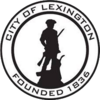Lexington, Illinois facts for kids
Quick facts for kids
Lexington
|
|||||
|---|---|---|---|---|---|
|
|||||

Location of Lexington in McLean County, Illinois.
|
|||||

Location of Illinois in the United States
|
|||||
| Country | United States | ||||
| State | Illinois | ||||
| County | McLean | ||||
| Townships | Lexington, Money Creek | ||||
| Area | |||||
| • Total | 2.05 sq mi (5.30 km2) | ||||
| • Land | 2.05 sq mi (5.30 km2) | ||||
| • Water | 0.00 sq mi (0.00 km2) | ||||
| Elevation | 748 ft (228 m) | ||||
| Population
(2020)
|
|||||
| • Total | 2,090 | ||||
| • Density | 1,021.01/sq mi (394.20/km2) | ||||
| Time zone | UTC-6 (CST) | ||||
| • Summer (DST) | UTC-5 (CDT) | ||||
| ZIP Code(s) |
61753
|
||||
| Area code(s) | 309 | ||||
| FIPS code | 17-43094 | ||||
| GNIS ID | 2395695 | ||||
| Wikimedia Commons | Lexington, Illinois | ||||
Lexington is a city located in McLean County, Illinois, United States. In 2020, about 2,090 people lived there.
There are two ideas about how Lexington got its name. One story says it was named after the Battle of Lexington. A general's father fought in that battle. The other idea is that it was named after the hometown of James Brown. He was one of the people who helped start the town.
Contents
History of Lexington
How Lexington Began
Lexington was planned on January 4, 1836. It was started by Asahel Gridley and James Brown. Gridley was a rich lawyer and banker from Bloomington. Brown was from Lexington, Kentucky.
Starting new towns was very popular then. Seven other towns were planned in McLean County around the same time. Lexington was designed with a public square in the middle. Its streets ran straight north-south and east-west. The town was built where forests met open prairie. It was also a bit away from the Mackinaw River.
First Sales and Early Days
Gridley and Brown first sold land lots in Lexington on April 30, 1836. They advertised that the town was on the main road to Chicago. This road connected Springfield through Bloomington.
They also said Lexington was near a good forest for timber. They mentioned two sawmills and a fulling mill nearby. Buildings were already being built. Buyers could even get credit for a year.
Life Before the Railroad
Between 1837 and 1854, Lexington faced tough times. A big economic downturn hit the country. The first store in Lexington failed quickly. Its building was moved to Bloomington. The first house was also moved to a nearby town called Clarksville.
No one was sure where the main road would go. Other towns tried to attract travelers. Many unsold lots in Lexington faced unpaid taxes. The town square was even used for grazing cattle.
But some people still believed in Lexington. Jacob Spawr moved there and built a special house. It was like two log cabins connected by a passage. This building served as his home, the post office, and a place for travelers to stay. Since Lexington was halfway between two county seats, it was a good stopping point. Famous people like Abraham Lincoln and Stephen Douglas often stayed there. By 1854, only about a dozen families lived in Lexington.
The Railroad Arrives
Everything changed on July 4, 1854. The railroad, later known as the Chicago and Alton, reached Lexington. A grain warehouse was moved and turned into a train station. New businesses, like a grain elevator, opened.
Three churches were built. The town even formed its own government. One of their first actions was to buy all the local whiskey and pour it into the street! A new hotel was also built. Lexington began to grow quickly. By 1865, the first brick building was put up.
On November 21, 1860, Abraham Lincoln came to Lexington by train. He said goodbye to his old friends. On May 2, 1865, another train passed through Lexington. This train carried Lincoln's body after he was assassinated.
A Big Court Case: People v. Chicago and Alton Railroad Company
Lexington became famous for a court case that changed American law. Railroads in the Midwest could charge whatever they wanted for shipping goods. This meant they could take a lot of money from farmers.
Illinois created a new state constitution in 1870. It allowed the government to control railroad prices. A lawyer named Ruben M. Benjamin from Bloomington helped write this part. He chose Lexington for a test case.
The Chicago and Alton Railroad charged $4.35 to ship lumber from Chicago to Bloomington. But they charged $5.00 to ship the same lumber a shorter distance to Lexington. Benjamin sued the railroad in 1871. The railroad said they charged less to Bloomington because there was more competition there.
The case went all the way to the United States Supreme Court. It became part of the "Granger Cases." These cases helped establish that governments could regulate, or control, large companies.
President Roosevelt Visits Lexington
One of the most remembered events in Lexington's history was when President Theodore Roosevelt visited. On July 15, 1902, about 20,000 people gathered near the train tracks. A long grandstand was decorated in red, white, and blue.
President Roosevelt, a hero from the Battle of San Juan Hill, shook hands with a few people. But he stayed on the train. He gave a short, exciting speech from the back of the train. The crowd cheered loudly. This was the only time a sitting president visited Lexington.
Lexington and Route 66
Transportation has always been important for Lexington. It started as a stop on the Chicago Trail, a stagecoach road. Its location on this road was mentioned when the town was first advertised in 1836. Later, being a railroad station helped it grow.
In the 20th century, train travel decreased. Car travel became more popular. By World War II, only two trains stopped in Lexington each day. Passenger train service ended in 1946.
In 1915, a paved road was built along the old stagecoach route. This road was called State Bond Route 4. It followed the path between Chicago and St. Louis. In 1926, this road became Route 66.
For the next 50 years, Lexington was a popular stop on this famous American highway. In 1955, Route 66 near Lexington was made wider. It became a four-lane highway with a grassy area in the middle.
Route 66 served the community until 1978. That's when Interstate 55 opened. I-55 also followed a similar path. After that, Route 66 was no longer an official highway. However, you can still drive on parts of the old Route 66 near Lexington. The southbound lanes from 1955 are now a two-lane county road.
Schools and Sports
Lexington is home to the John Patton Log Cabin. It also has the Lexington Community Unit School District 7 campus. This includes Lexington High School.
Geography
In 2010, Lexington covered about 1.33 square miles (3.44 square kilometers) of land. There is no water area within the city limits.
Population Information
| Historical population | |||
|---|---|---|---|
| Census | Pop. | %± | |
| 1880 | 1,254 | — | |
| 1890 | 1,187 | −5.3% | |
| 1900 | 1,415 | 19.2% | |
| 1910 | 1,318 | −6.9% | |
| 1920 | 1,301 | −1.3% | |
| 1930 | 1,292 | −0.7% | |
| 1940 | 1,284 | −0.6% | |
| 1950 | 1,181 | −8.0% | |
| 1960 | 1,244 | 5.3% | |
| 1970 | 1,615 | 29.8% | |
| 1980 | 1,806 | 11.8% | |
| 1990 | 1,809 | 0.2% | |
| 2000 | 1,912 | 5.7% | |
| 2010 | 2,060 | 7.7% | |
| 2020 | 2,090 | 1.5% | |
| Decennial US Census | |||
In 2000, there were 1,912 people living in Lexington. There were 760 households and 550 families. The population density was about 1,820 people per square mile (703 people per square kilometer).
About 26.9% of the people were under 18 years old. About 12.3% were 65 years or older. The average age was 37 years. For every 100 females, there were about 96 males.
Notable People
- Alice Ambrose (1906–2001), a philosopher who taught at Smith College.
- Gilbert L. Deavers (1931–2006), born in Lexington, was an Illinois state representative, teacher, and businessman.
- Odus Creamer Horney, a U.S. Army brigadier general.
- Ed Kinsella (1880–1976), an MLB pitcher for the Pittsburgh Pirates and St. Louis Browns.
- William R. Roy (1926–2014), a congressman from Kansas.
- Arthur J. Scrogin (1853–1926), born in Lexington, was an Illinois state representative and farmer.
- Joseph L. Settles (1871–1943), one of the people who helped start the fraternity Tau Kappa Epsilon.
- John A. Sterling (1857–1918), born in Lexington, was a congressman.
- Alex Tanney (born 1987), a football coach and former professional quarterback.
See also
 In Spanish: Lexington (Illinois) para niños
In Spanish: Lexington (Illinois) para niños



